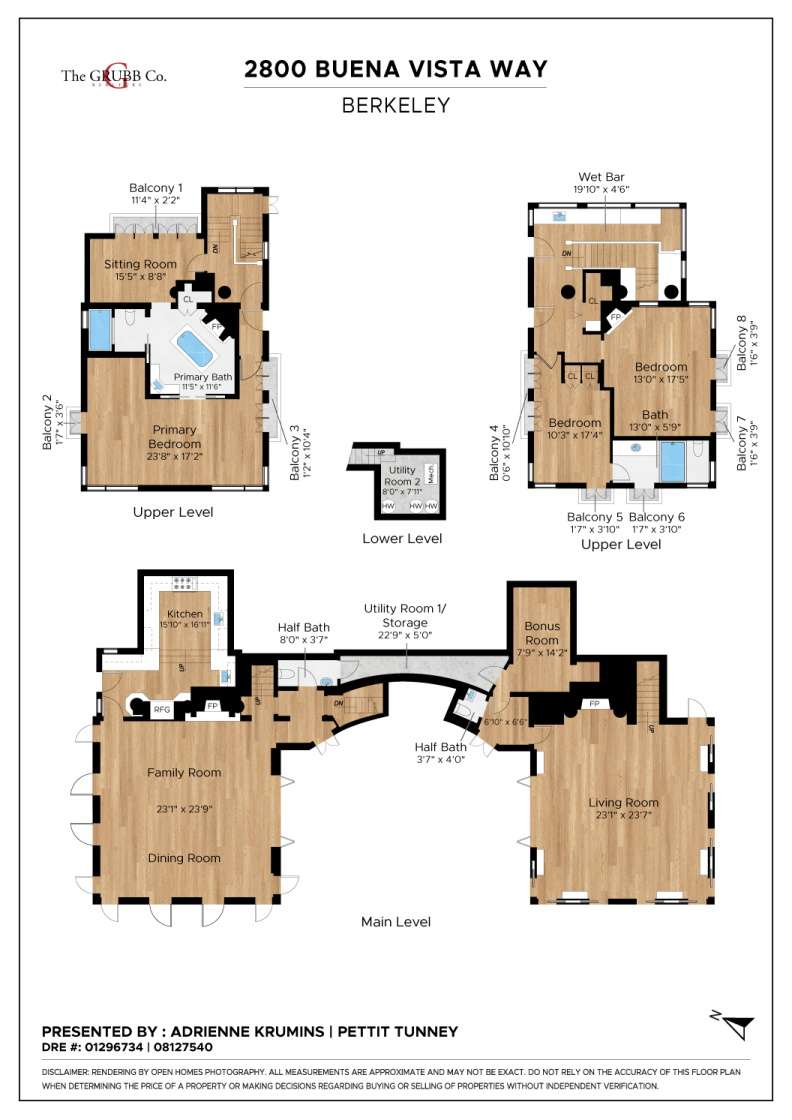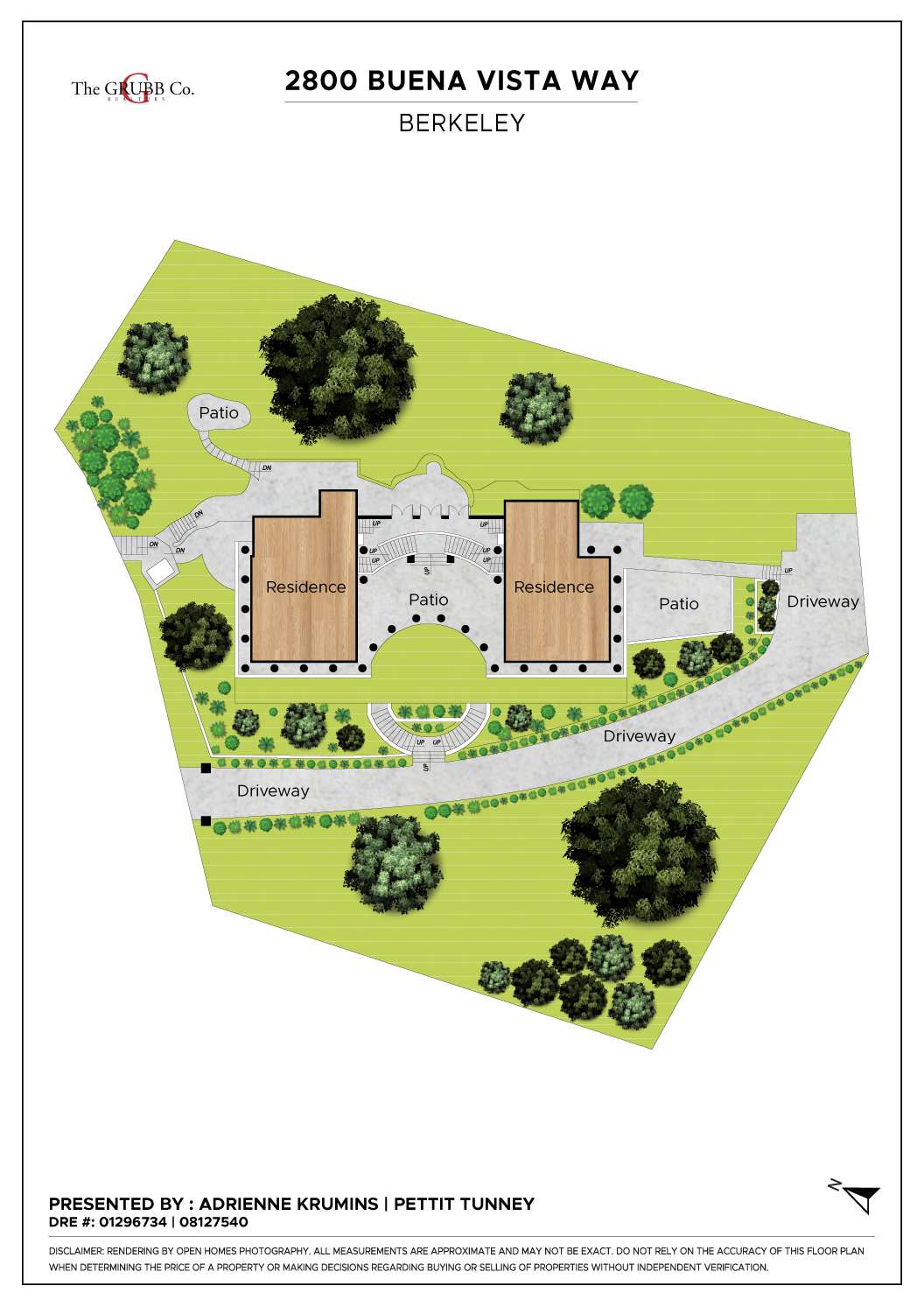Adrienne Krumins, Anian Tunney & Joel Goodrich Present
Extraordinary Bernard Maybeck Designed Landmark Estate
$5,000,000
All Property Photos
Property Details
beds
3
baths
4
interior
3,991 sq ft
neighborhood
La Loma Park / North Berkeley
Divided into North and South wings, this stunning home enjoys unparalleled views of the Bay Area’s world-renowned landmarks- from the San Francisco and Oakland Skylines, as well as the sparkling waters of the Bay – to the Golden Gate and Bay Bridges and beyond. Sliding glass doors surrounding the living spaces provide a wonderful indoor/ outdoor flow for a casual contemporary lifestyle as well as for grand-scale entertaining. Designed in 1911 by the legendary starchitect Bernard Maybeck, this timeless residence has been thoughtfully updated to harmonize with 21st-Century living...
Just a few minutes’ drive from the world-class research and educational facilities of the University of California Berkeley, this luxuriously serene retreat also enjoys close proximity to the charming shopping, dining, entertainment and cultural amenities of Berkeley, Oakland, and San Francisco.
PROPERTY PROFILE
- Architecturally significant Roman-style Villa. Originally designed circa 1911 by legendary architect Bernard Maybeck and completed circa 1914 by A. Randolph Monroe. Rebuilt in 1924 and effective year built 1940 as County of Alameda Tax Records
- Designated Berkeley Historic Landmark No.173 and listed in the California State Historic Resources Inventory.
- Three bedrooms, two full baths, two powder rooms, two entertaining spaces, library/ den, eight balconies, kitchen and laundry room spread out over the North and South Wings of the residence
- 3 car driveway parking
- Grand outdoor semi-circular Pavilion with 16 Corinthian columns
- South and East gardens
- 3,991 square feet of living space as per draftsman on a 16,560 square foot lot as per the County of Alameda Tax Records; Buyer to independently verify
THE RESIDENCE
THE ENTERTAINING PAVILION
A double circular stone staircase ascends from the cobblestone driveway and leads to the semi-circular grand entertaining pavilion and lawns. This space is framed by 16 exquisite grand-scaled Corinthian columns- creating an extraordinarily dramatic entrance into the residence. This double story open-air Roman-style pavilion features a double staircase leading up to a mezzanine level where a rear window frames the serene forest backdrop– perfect for performers or as an extended entertaining space. Enjoying dramatic views encompassing the Oakland and San Francisco Skylines, the Berkeley Marina, the Bay and the Golden Gate Bridges, this unique architectural space flows seamlessly to the South garden adorned with Grecian-style frescoes. This creates a harmonious outdoor extension of the interior spaces, ideal for both intimate gatherings and grand celebrations.
THE NORTH WING
The Main Level
Situated right off the grand pavilion, an elegantly proportioned open living/ dining/ entertaining space with patina-ed cement stone flooring is crowned by high ceilings punctuated with the original fresco-ed beams, and features an imposing wood-burning fireplace with marble and wrought iron detailing. Nine glass sliding doors plus a double French door flood the space with natural light while framing the lushly verdant surrounding and smoothly continuing the indoor/ outdoor flow of the grand pavilion.
A large chef’s kitchen with skylight is superbly equipped with double door stainless SubZero and Bosch dishwasher, as well as a 6-burner Monogram gas stove with griddle and commercial hood. Veined Marble counters, custom cabinetry and classic fixtures provide lovely accents, while outdoor access leads directly to the North patio.
An elegant powder room with warm wood paneled walls and a classic pedestal sink complete this level of the home.
The Upper Level
A knotty pine room, dramatically punctuated with tops of the Corinthian columns arising from the main level, features a Juliette balcony- creating an intimate space perfect for a library/ office/ media room.
The elegantly serene primary suite is a wonderful oasis, with three balconies overlooking the stunning views of the San Francisco Bay. From the twinkling lights of the skylines to the Golden Gate Bridge and the Pacific Ocean, all magically framed by the surrounding park-like setting. The spa-like bath enjoys cathedral ceilings with skylight, marble fireplace, floating marble bath and separate walk-in shower. Lovely outlooks over the surrounding gardens, forest and entertaining pavilion complete the charm of this luxurious retreat.
THE SOUTH WING
The Main Level
The grand-scaled living and entertaining room, mirroring the elegance of its counterpart in the North Wing, is adorned with stone and shell flooring and features a classic fireplace. Nine sliding glass doors, along with a double French door entry, bathe the space in natural light.
A powder room, a convenient laundry room, and a mechanical room complete this level.
The Upper Level
A wet bar, illuminated by a skylight and equipped with a sink and under-the-counter fridge, provides access to the mezzanine overlooking the entertaining pavilion and the lush greenery surrounding the residence.
The comfortable second bedroom in this wing boasts a Juliette balcony with romantic views of the Bay and the twinkling city lights below. This room also includes a luxurious marble bath with a walk-in shower and third bedroom space.
THE HISTROY
Temple of Wings is a historic Greco-Roman style private estate located at 2800 Buena Vista Way in the La Loma Park neighborhood of Berkeley, California. The main structure was designed by Bernard Maybeck and completed by A. Randolph Monro. It was originally designed as an open-air private home dedicated to modern and contemporary dance. It has been listed by the city as a Berkeley Landmark (no. 173) since January 6, 1992, and is listed in the California State Historic Resources Inventory. It is known as the Temple of Wings, the Boynton House, and the Charles C. Boynton House.
Temple of Wings was originally the home of attorney Charles Calvin Boynton, his wife Florence Treadwell Boynton, and their eight children. Florence Treadwell Boynton was “California’s chief exponent of rhythmic gymnastics,” and promoted “open air motherhood,” a parenting philosophy that maximized children’s outdoor time. She was a childhood friend and admirer of Isadora Duncan. Boynton created a home and a dance school that reflected Duncan’s philosophies. The estate was passed down for at least four generations of the Boynton family (later known as the Quitzow and Braun family), and was last sold in 1994 to the Getty family.
It was originally designed and constructed as a Greco-Roman colonnaded open-air private residence by architect Bernard Maybeck in 1911. The project was completed in 1914 by Arthur Randolph Monro, and it featured hung canvas in lieu of walls.
Clarence Dakin and Edna Deakin remodeled the building in 1924, after the building had caught fire the year prior. During the remodel, they added an enclosed house inside of the colonnade with two levels, and the first level had multiple rooms dedicated as dance studios.
Philanthropists Ann and Gordon Getty acquired the Temple of the Wings property in 1994, returning it to its roots with furnishing from the British and American Arts and Crafts movement and Pre-Raphalite painting. During their ownership, the home was meticulously maintained within the historic nature of its origin. C/O - Wikipedia
THE ARCHITECT
Bernard Ralph Maybeck (February 7, 1862 – October 3, 1957) was an American architect in the Arts and Crafts Movement of the early 20th century. He worked primarily in the San Francisco Bay Area, designing public buildings, including the Palace of Fine Arts in San Francisco, and also private houses, especially in Berkeley, where he lived and taught at the University of California. A number of his works are listed on the National Register of Historic Places.
Maybeck was born in New York City, the son of a German immigrant and studied at the Ecole des Beaux Arts in Paris, France. He moved to Berkeley, California, in 1892. He taught engineering drawing and architectural design at the University of California, Berkeley from 1894 to 1903, and acted as a mentor for a number of other important California architects, including Julia Morgan and William Wurster. In 1951, he was awarded the Gold Medal of the American Institute of Architects.[citation needed]
Maybeck was equally comfortable producing works in the American Craftsman, Mission Revival, Gothic revival, Arts and Crafts, and Beaux-Arts styles, believing that each architectural problem required development of an entirely new solution. While working in the office of A. Page Brown in San Francisco, Maybeck probably contributed to the Mission Style California Building at the 1893 World’s Columbian Exposition in Chicago and was one of the designers of the San Francisco Swedenborgian Church, which included the first Mission Style chair. For the 1915 Panama-Pacific International Exposition, he designed the domed Palace of Fine Arts and also the “House of Hoo Hoo”, a “lumberman’s lodge” made of rough-barked tree trunks. The Palace of Fine Arts was seen as the embodiment of Maybeck’s elaboration of how Roman architecture could fit within a California context. Maybeck said that the popular success of the Palace was due to the absence of a roof connecting the rotunda to the art gallery building, along with the absence of windows in the gallery walls and the presence near the rotunda of trees, flowers and a water feature. In 1928, he designed the Harrison Memorial Library in Carmel in a Spanish Eclectic style.
In his long-time home city of Berkeley, the 1910 First Church of Christ, Scientist, Berkeley is designated a National Historic Landmark and is considered one of his masterpieces. In 1911, he designed “Temple of Wings” in the Berkely Hills, an iconic Roman-stye villa. In 1914 he oversaw the building of the Maybeck Recital Hall in Berkeley. On flatter sites such as the city of San Francisco, the campus of the University of California, Berkeley, and the Loch Lin General Plan for Principia College in Illinois, his proposals were guided by more formal Beaux Arts planning principles.
One of Maybeck’s most interesting office buildings is the home of the Family Service Agency of San Francisco at 1010 Gough Street, from 1928, which is on the city’s Historic Building Register. Some of his larger residential projects, particularly those in the Berkeley hills such as La Loma Park, have been compared to the ultimate bungalows of the architects Greene and Greene.
Maybeck had many ideas about town planning that he elaborated throughout his career. As a citizen of Berkeley from the 1890s, he was intimately involved in the Hillside Club. His associations and work there helped evolve ideas about hillside communities. Maybeck developed a number of firm beliefs in how civilization and the land should relate to each other. Two overriding principles would be: 1) the primacy of the landscape - geology, flora and fauna were not to be subdued by architecture so much as enhanced by architecture 2) roads should pattern the existing grade and not be an imposition upon it. There were other principles he would elucidate, such as a shared public landscape, but these were key, and helped Berkeley evolve into a paradigm for hillside living that was organic and unique. Maybeck’s visions for communities in the East Bay were also a conscientious counterpoint to across the bay where in San Francisco city planning was much more conventional, forced, and regimented into expansive grids of streets. Its grids, imposed in places on very steep grades, resulted in extremely steep streets, sidewalks and urban transitions, some almost comically so.
He also developed a comprehensive town plan for the company town of Brookings, Oregon, a clubhouse at the Bohemian Grove, and many of the buildings on the campus of Principia College in Elsah, Illinois.
A lifetime fascination with drama and the theatre can be seen in much of Maybeck’s work. In his spare time, he was known to create costumes, and also designed sets for the amateur productions at the Hillside Club.
Bernard Maybeck died in 1957 and is buried in the Mountain View Cemetery in Oakland, California.
Floor Plans


about this
Neighborhood
The homes perched on the North Berkeley Hills boast flowering hillside gardens and a variety of architectural styles, ranging from charming bungalows to contemporary masterpieces by notable architects. This diversity of architecture not only contributes to the aesthetic appeal, but also reflects the rich history and evolving character of North Berkeley. North Berkeley Hills residents can enjoy views of the San Francisco and Oakland skylines, the Golden Gate Bridge, Alcatraz Island, and Mount Tamalpais—in fact, many properties enjoy some of the best panoramic views in the entire Bay Area. Additionally, the area is home to an elaborate system of walking pathways and “secret” stairs, most notably documented in the “Berkeley and its Pathways” maps that are widely available and inspire pedestrian shortcuts and exercise. It’s an incredibly peaceful residential neighborhood, yet not far from the hustle and bustle of Berkeley’s more urban areas.
For even more incredible views plus a variety of great outdoor activities, residents can take a short trip to nearby Tilden Regional Park. Free activities available at Tilden Park include a beautiful botanical garden, the Little Farm, and nearly 40 miles of scenic hiking trails. For a small fee, the public can also swim at Lake Anza, take a spin on the Merry-Go-Round (built in 1911), enjoy a round of golf at Tilden Park Golf Course, or take a ride through the trees on the beloved, scaled-down Steam Train—a delight for young and old alike.
Central Berkeley, which includes the UC Berkeley campus, its surroundings and the bustling downtown area, is a well-loved mecca for arts and culture, a vibrant food and restaurant scene. It’s and yet very walkable and bikeable, with many tree-lined streets around small to medium-sized single family homes (along with some student housing). A great transportation system, numerous small neighborhood parks, libraries, and a wonderful sense of community are the things that residents here treasure, along with the easy access to hiking and biking opportunities in Tilden Park and beyond.
The Claremont District is divided among the original Claremont District—the older, distinguished neighborhood from the turn of the century consisting primarily of grand, historic and elegant homes by some of the area’s most notable architects—and the Claremont Hills, above the Claremont Hotel. The original Claremont neighborhood, in the more walkable lower hills close to Rockridge, is marked by quiet tree-lined streets. Many of the homes have lush gardens and mature trees, giving this neighborhood a distinctive, old-world feeling with some of the Bay Area’s most desirable residences. A small shopping area nearby features the popular Souvenir coffeeshop, a local grocery with butcher, a flower store and some additional amenities such as access to nearby hiking trails, bike routes, parks and the great outdoors. Higher up in the Claremont Hills section, more contemporary custom view homes are spacious and luxurious, and enjoy breathtaking views of the Bay, Bridges, and City.
West Berkeley has a variety of wonderful, one-of-a-kind and places to eat and shop. 4th Street is a popular shopping destination, the corner of San Pablo and Dwight offers a rich array of cafes and restaurants, as well as small shops, artists studios and many small businesses and libraries sprinkled throughout the area.

Adrienne Krumins
The Grubb Company
Realtor®
- DRE:
- #01296734
- Mobile:
- 510.928.4521
- Office:
- 510.928.4521
AnianandAdrienne.com

Anian Pettit Tunney
The Grubb Company
Broker Associate/Realtor®
- DRE:
- #08127540
- Office:
- 510.339.0400 x217
https://anianandadrienne.com/

Joel Goodrich
Get In Touch
Thank you!
Your message has been received. We will reply using one of the contact methods provided in your submission.
Sorry, there was a problem
Your message could not be sent. Please refresh the page and try again in a few minutes, or reach out directly using the agent contact information below.

Adrienne Krumins
The Grubb Company
Realtor®
- DRE:
- #01296734
- Mobile:
- 510.928.4521
- Office:
- 510.928.4521

Anian Pettit Tunney
The Grubb Company
Broker Associate/Realtor®
- DRE:
- #08127540
- Office:
- 510.339.0400 x217

Joel Goodrich